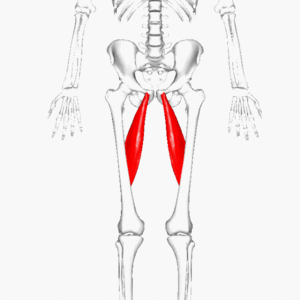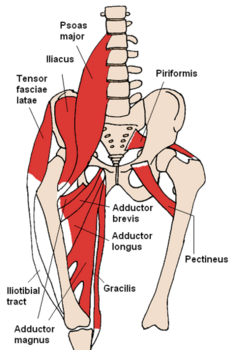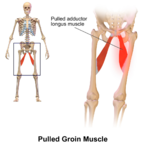Adductor Longus: Difference between revisions
Leana Louw (talk | contribs) No edit summary |
Memoona Awan (talk | contribs) No edit summary |
||
| (16 intermediate revisions by 4 users not shown) | |||
| Line 1: | Line 1: | ||
'''Original Editor '''- [[User:Leana Louw|Leana Louw]] | |||
'''Original Editor '''- [[Leana Louw|Leana Louw]] | |||
'''Top Contributors''' - {{Special:Contributors/{{FULLPAGENAME}}}} | '''Top Contributors''' - {{Special:Contributors/{{FULLPAGENAME}}}} | ||
</div> | </div> | ||
== | ==Introduction== | ||
Adductor longus is one of the adductor muscles of the medial thigh.<ref name=":0">Moore KL, Dalley AF, Agur AMR. | [[File: Adductor longus.gif|thumb|alt=This is the image of the Adductor Longus muscle which originates from the anterior aspect of the pubic body inferior to the pubic crest and expands into a fan shape, attaching broadly to the linea aspera on the middle third of the femur. |Adductor longus]]The adductor longus is one of the adductor muscles of the medial thigh.<ref name=":0">Moore KL, Dalley AF, Agur AMR. Clinically oriented anatomy. Philadelphia: Wolters Kluwer, 2010.</ref> Together with the [[Adductor Brevis|adductor brevis]], [[Adductor Magnus|adductor magnus]], [[gracilis]] and [[Obturator Externus|obturator externus]], it makes up the [[Hip Adductors|hip adductors]].<ref name=":0" /> | ||
This large fan-shaped muscle is situated most anteriorly of this group and covers the middle part of the [[Adductor Magnus|adductor magnus]] and the anterior part of the [[Adductor Brevis|adductor brevis]].<ref name=":0" /> | |||
The muscle forms the medial border of the [[Femoral Triangle|femoral triangle]]. | |||
=== | The muscles in this compartment are believed to have evolved from hip extensor and flexor columns<ref name=":1">Ken Hub [https://www.kenhub.com/en/library/anatomy/adductor-longus-muscle Adductor Longus] Available: https://www.kenhub.com/en/library/anatomy/adductor-longus-muscle<nowiki/>(accessed 20.1.2022)</ref>. | ||
===Origin=== | |||
A strong tendon from the anterior aspect of the pubic body inferior to the pubic crest.<ref name=":0" /> | |||
=== | ===Insertion=== | ||
Expands into a fan shape, attaching broadly to the linea aspera on the middle third of the femur.<ref name=":0" /> | |||
This insertion point is between the insertion of the [[Adductor Magnus|adductor magnus]] and the origin of the [[Vastus Medialis|vastus medialis]] muscle, and inferior to the [[Adductor Brevis|adductor brevis]] insertion.<ref name=":1" /> | |||
<gallery widths="250px" heights="350px"> | |||
File: Adductor_Longus_attachments.png| muscle insertion | |||
File: Adductor_magnus.png|other muscle </gallery> | |||
== | ===Nerve=== | ||
Anterior division of [[Obturator Nerve|obturator nerve]] (L2, '''L3''', L4).<ref name=":0" /> | |||
== | == Function== | ||
The main action of the adductor group of muscles is to adduct the thigh at the hip joint. | |||
== | #The adductor longus muscle also plays a role in external/lateral rotation and flexion of the thigh. | ||
#Along with the other hip adductors it helps to stabilise the pelvis in standing and aids in balancing the body on the lower limb during walking.<ref name=":0" /><ref name=":1" /> | |||
{{#ev:youtube|U6imQsMgGOI|300}}<ref>.Kenhub. Kenhub - Learn Human Anatomy. Available from: https://www.youtube.com/watch?v=U6imQsMgGOI [last accessed 20/12/2023]</ref> | |||
==Physiotherapy Relevance== | |||
[[File:Pulled Groin Muscle.png|thumb|Pulled Groin Muscle|alt=|145x145px]][[Adductor Tendinopathy]] is a common cause of medial leg and [[Groin Strain|groin pain]], especially among athletes. It is common among injuries in such sports as eg ice skating, horse riding, soccer, football, karate, and running. Sudden changes in direction cause a quick adduction against a large abduction force thereby stressing the tendon, most commonly at its origin. It is caused by a disproportional strain of the muscles, often in combination with a poor warm-up and a lack of [[stretching]].<ref name=":2">[[Adductor Brevis]]</ref> | |||
==Assessment and Treatment== | |||
[[File:Soccer kick.jpeg|thumb|142x142px|Soccer, a game with adductor injury .|alt=]] | |||
Adductor injuries are often overlooked. An early assessment is essential to prevent it from becoming a career-threatening injury for an athlete. | |||
For a guide to Physiotherapy treatment and assessment see [[Groin Strain]] [[Adductor Tendinopathy]] | |||
*It is essential to do a thorough assessment of the pelvis and [[Core Strengthening|core]] as well as the thigh muscles. Designing a [[Strength Training|strengthening]] program to address which muscles are weak and which muscles are tight is vital. Treatment should include strengthening the muscles around the pelvis and core, alongside stretches to be completed following all training sessions.<ref name=":2" /> | |||
*[[Manual Muscle Testing: Hip Adduction|Manual muscle testing]]:<ref>Hislop H, Avers D, Brown M. [https://books.google.co.za/books?hl=en&lr=&id=peNOAQAAQBAJ&oi=fnd&pg=PP1&dq=muscle+testing&ots=mxJRzfX8_q&sig=J-rFmGV3dwKthAW-Q0uYki-B8aI#v=onepage&q=muscle%20testing&f=false Daniels and Worthingham's Muscle Testing: Techniques of manual examination.] Elsevier Health Sciences; 2013.</ref> | |||
*[[Adductor Squeeze Test|Adductor squeeze test]] | |||
{{#ev:youtube|s0gKvvbFX2I|300}}<ref>. | |||
Rehab My Patient. How to strengthen your adductor longus. Available from: https://www.youtube.com/watch?v=s0gKvvbFX2I [last accessed 20/12/2023]</ref> | |||
==References== | |||
<references /> | <references /> | ||
[[Category:Anatomy]] | [[Category:Anatomy]] | ||
[[Category:Muscles]] | [[Category:Muscles]] | ||
Latest revision as of 20:01, 20 December 2023
Original Editor - Leana Louw
Top Contributors - Lucinda hampton, Leana Louw, Memoona Awan, Kim Jackson, Vidya Acharya and Ines Musabyemariya
Introduction[edit | edit source]
The adductor longus is one of the adductor muscles of the medial thigh.[1] Together with the adductor brevis, adductor magnus, gracilis and obturator externus, it makes up the hip adductors.[1]
This large fan-shaped muscle is situated most anteriorly of this group and covers the middle part of the adductor magnus and the anterior part of the adductor brevis.[1]
The muscle forms the medial border of the femoral triangle.
The muscles in this compartment are believed to have evolved from hip extensor and flexor columns[2].
Origin[edit | edit source]
A strong tendon from the anterior aspect of the pubic body inferior to the pubic crest.[1]
Insertion[edit | edit source]
Expands into a fan shape, attaching broadly to the linea aspera on the middle third of the femur.[1]
This insertion point is between the insertion of the adductor magnus and the origin of the vastus medialis muscle, and inferior to the adductor brevis insertion.[2]
Nerve[edit | edit source]
Anterior division of obturator nerve (L2, L3, L4).[1]
Function[edit | edit source]
The main action of the adductor group of muscles is to adduct the thigh at the hip joint.
- The adductor longus muscle also plays a role in external/lateral rotation and flexion of the thigh.
- Along with the other hip adductors it helps to stabilise the pelvis in standing and aids in balancing the body on the lower limb during walking.[1][2]
Physiotherapy Relevance[edit | edit source]
Adductor Tendinopathy is a common cause of medial leg and groin pain, especially among athletes. It is common among injuries in such sports as eg ice skating, horse riding, soccer, football, karate, and running. Sudden changes in direction cause a quick adduction against a large abduction force thereby stressing the tendon, most commonly at its origin. It is caused by a disproportional strain of the muscles, often in combination with a poor warm-up and a lack of stretching.[4]
Assessment and Treatment[edit | edit source]
Adductor injuries are often overlooked. An early assessment is essential to prevent it from becoming a career-threatening injury for an athlete.
For a guide to Physiotherapy treatment and assessment see Groin Strain Adductor Tendinopathy
- It is essential to do a thorough assessment of the pelvis and core as well as the thigh muscles. Designing a strengthening program to address which muscles are weak and which muscles are tight is vital. Treatment should include strengthening the muscles around the pelvis and core, alongside stretches to be completed following all training sessions.[4]
References[edit | edit source]
- ↑ 1.0 1.1 1.2 1.3 1.4 1.5 1.6 Moore KL, Dalley AF, Agur AMR. Clinically oriented anatomy. Philadelphia: Wolters Kluwer, 2010.
- ↑ 2.0 2.1 2.2 Ken Hub Adductor Longus Available: https://www.kenhub.com/en/library/anatomy/adductor-longus-muscle(accessed 20.1.2022)
- ↑ .Kenhub. Kenhub - Learn Human Anatomy. Available from: https://www.youtube.com/watch?v=U6imQsMgGOI [last accessed 20/12/2023]
- ↑ 4.0 4.1 Adductor Brevis
- ↑ Hislop H, Avers D, Brown M. Daniels and Worthingham's Muscle Testing: Techniques of manual examination. Elsevier Health Sciences; 2013.
- ↑ . Rehab My Patient. How to strengthen your adductor longus. Available from: https://www.youtube.com/watch?v=s0gKvvbFX2I [last accessed 20/12/2023]











